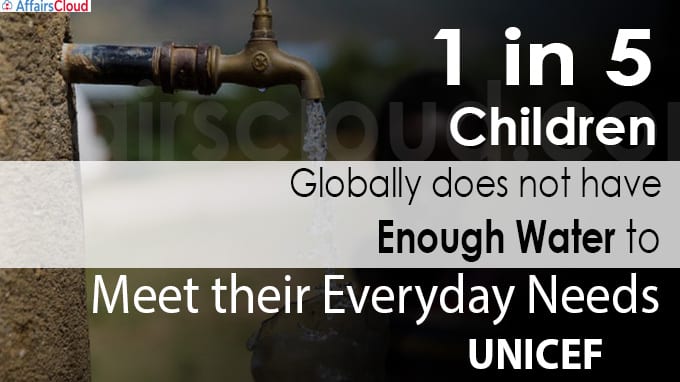 According to the report ‘Reimagining WASH:Water Security For All’ released by UNICEF (United Nations Children’s Fund), globally more than 1.42 Billion people, including 450 million children live in areas of high, or extremely high, water vulnerability.
According to the report ‘Reimagining WASH:Water Security For All’ released by UNICEF (United Nations Children’s Fund), globally more than 1.42 Billion people, including 450 million children live in areas of high, or extremely high, water vulnerability.
- It essentially means that globally, 1 in 5 children worldwide do not have enough water to meet their everyday needs.
- Eastern and Southern Africa regions have the highest proportion of children (58%) living in areas with extremely high water vulnerability. It is followed by West & Central Africa (31%), South Asia (25%), and the Middle East (23%)
- South Asia is home to the largest number of children living in areas of high or extremely high water vulnerability – more than 155 Million children.
- The report is part of UNICEF’s ‘Water Security for All’ initiative.Global water demand is projected to increase by 20 to 30 per cent per year by 2050.
- More than 2 crores (20 Million) children in India are experiencing extremely high water vulnerability.
Goal
- UNICEF has set a goal to reach 450 Million Children & their families (1.42 Billion people) with resilient solutions for improving the water vulnerability by 2025.
- All children to have access to a safe and affordable water supply and to live in water secure communities by 2030.
‘37 Hotspots’
- The report has highlighted 37 hot-spot countries where children are faced with High Water Vulnerability.
- Some of the countries are Afghanistan, Burkina Faso, Ethiopia, Haiti, Kenya, Niger, Nigeria, Pakistan, Papua New Guinea, Sudan, Tanzania & Yemen.
- Hotspot countries are those which meet any one of the following criteria: ≥ 60% High Water Vulnerability; ≥ 40% Extremely High Water Vulnerability; ≥ 40% children in High and Extremely High Water Vulnerability; ≥ 2M people in High and Extremely High Water Vulnerability
Key Points
- Children in more than 80 countries live in areas with high or extremely high water vulnerability.
- Less than 3% of the World’s water resources is freshwater, and it is growing increasingly becoming scarce.
- Global water demand is projected to increase by 20 to 30 % per year by 2050.
Causes of Water Scarcity
The report has listed various factors responsible for increasing water scarcity.
- Rapid Population Growth
- Urbanization
- Water misuse & mismanagement
- Climate change & extreme weather events
- Increasing Water Stress
Fact
- According to a UNICEF report from 2017, nearly 600 Million or almost 1 in 4 children globally live in areas of extremely high water stress by 2040.
‘Water Security for All’
- It is an initiative launched by UNICEF to ensure that every child has access to sustainable and climate-resilient water services.
Recent Related News:
i.December 14, 2020, In accordance with the WHO and UNICEF report, “Fundamentals first: Universal water, sanitation, and hygiene services in health care facilities for safe, quality care” around 1.8 billion people are at heightened risk of COVID-19 and other diseases because of lack of WASH provision.
About United Nations Children’s Fund (UNICEF):
Executive Director– Henrietta Holsman Fore
Headquarter– New York, USA




